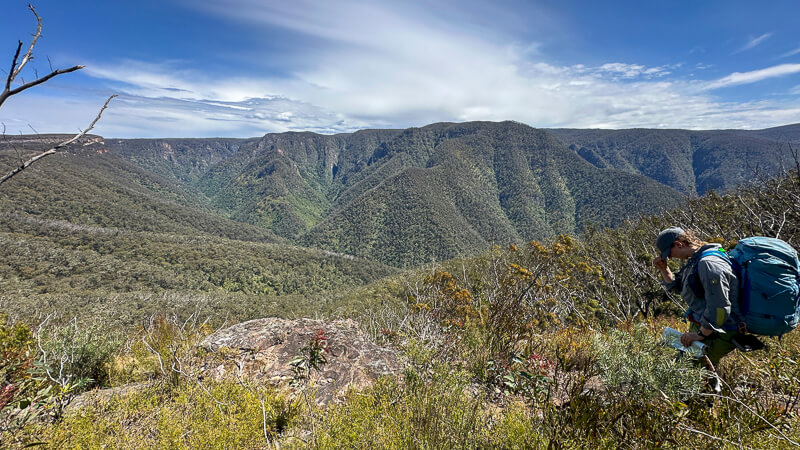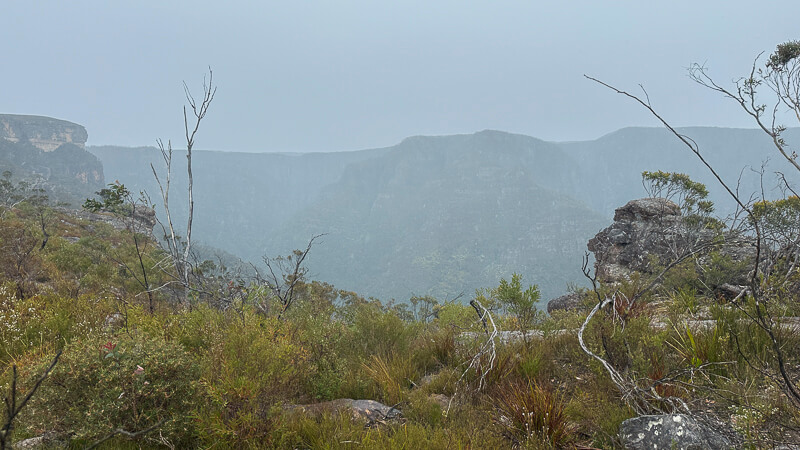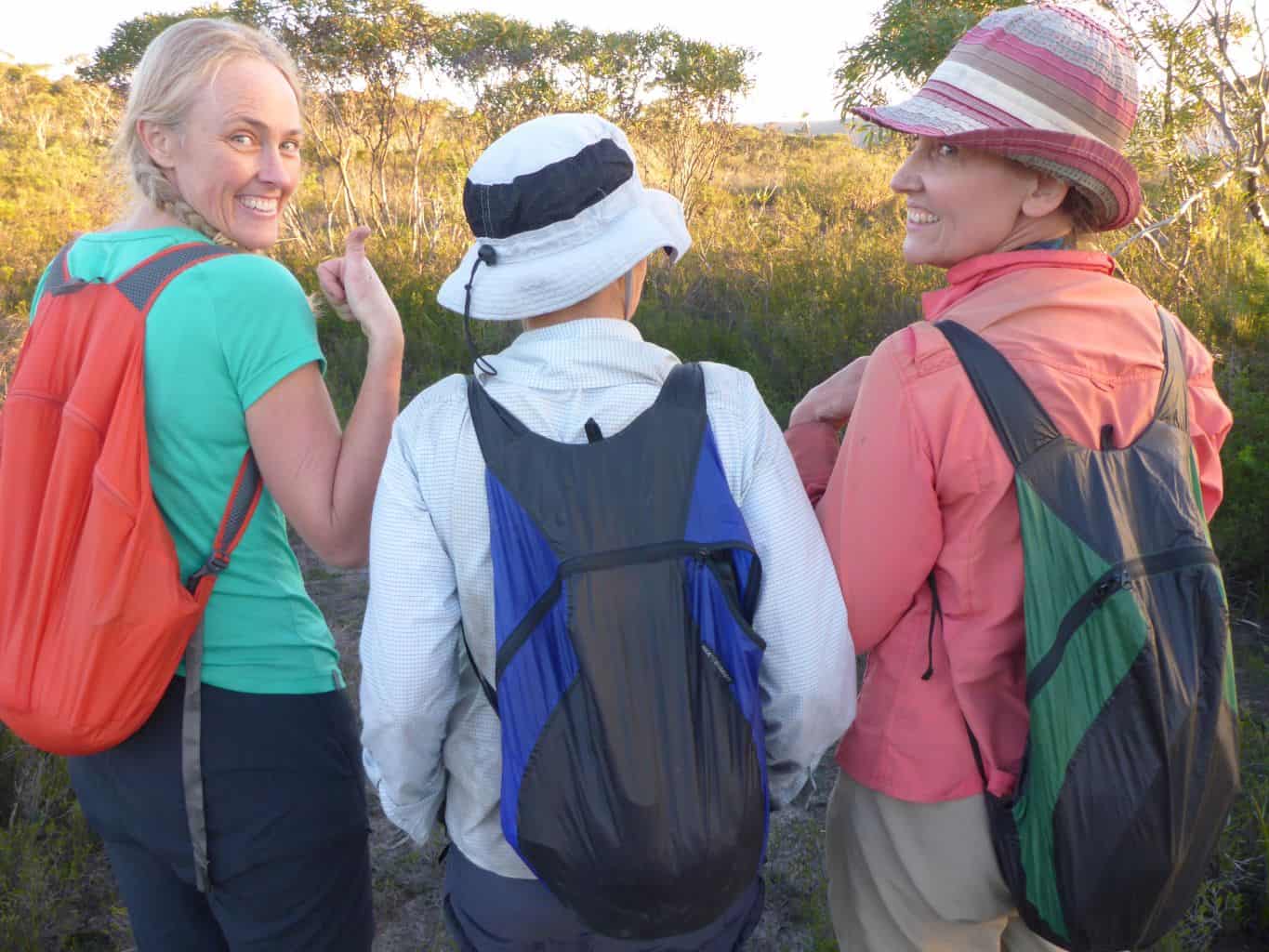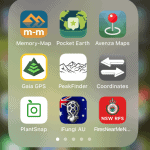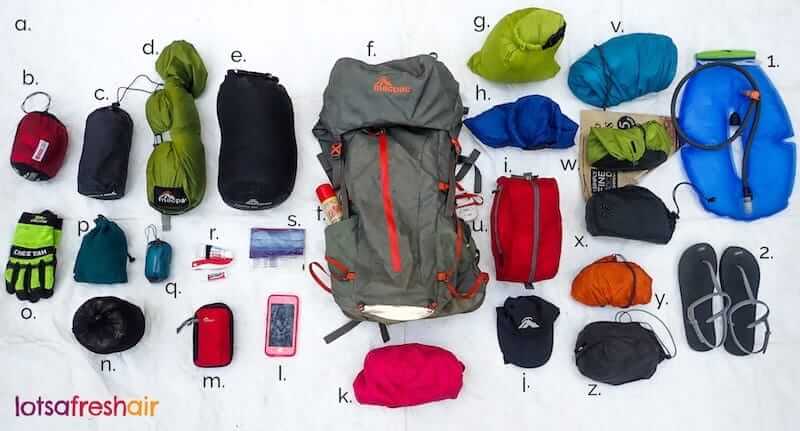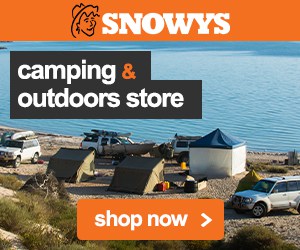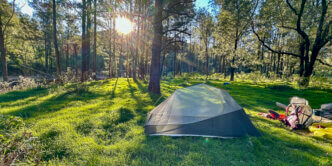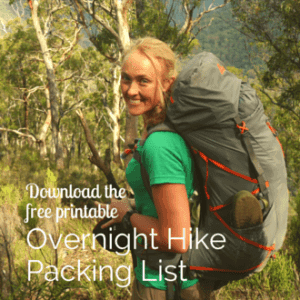- Why aim for a lightweight backpack?
- Shelter and Sleep System
- Kitchen and Hydration
- Food for Four Days (approx 2.5kg)
- Weather Protection
- Macpac Pisa Technical Warmth - 320g
- What did I wear?
- Safety and Communication
- Personal Care and Hygiene
- The Complete Picture
- Where I Could Cut Even More Weight
- Final Thoughts
Why aim for a lightweight backpack?
When you’re heading out for four days in one of NSW most remote and rugged Wilderness areas, every gram counts. In Kanangra-Boyd National Park—with its steep n’ deep gorges, breathless ascents and weather that can change in a heartbeat—doubly so. After years of tweaking and experimenting, I was stoked to pack for this trip and discover the weigh-in at 10.5 kg + water. I’ve always had a 10kg pack as a bit of a goal, but never really put much effort into it – until now.
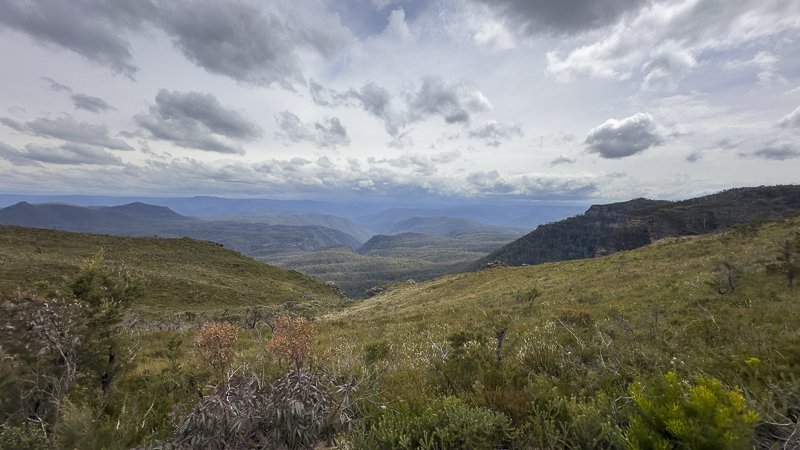
The park suffered badly in the 2019-2020 bushfires, and the regrowth has completely obliterated many of the old routes and tracks. I knew I needed to pack light because the elevation gain and loss over four days was substantial—around 3,000 metres of ascent AND descent was ahead of us. The thick regrowth meant serious scrub-bashing (full-body armour would be handy, but it doesn’t pack light). It was October, with forecasts hitting 24-26°C+, which meant some hot, exposed climbs on spurs that lost their shade in the fires. Light pack or suffer—those were my options. What we found, was that the forecast temps felt much higher in the dry, exposed spurs and ridges. My recommendation is not to attempt anything big out there if it’s likely to be >26c.
Here’s exactly what I carried on this trip, why each piece worked for me, and how you might put together something similar for your next adventure. I’m not saying my way is the right approach for everyone—just what I’ve found works for me.
Note: Click the item headings for links to more info on each product. Some of these are affiliate links which means I may earn a small (like 3% if I’m lucky!) commission on any sales, but you pay no more. It’s one way of supporting the work I do ~ thanks!
Shelter and Sleep System
Whippa 60L Overland Pack – 1.175kg
This Blue Mountains-made pack from Summit Gear has become my absolute favourite for longer trips. The 60-litre capacity swallows four days of food and gear without complaint and room for more. The way it distributes weight across my hips and shoulders (even without a frame) makes those long days much more bearable. What I really appreciate is how tough it is—Kanangra’s scrubby vegetation loves to grab at packs, and the Overland just shrugs it off. Check out my gear review for more details.
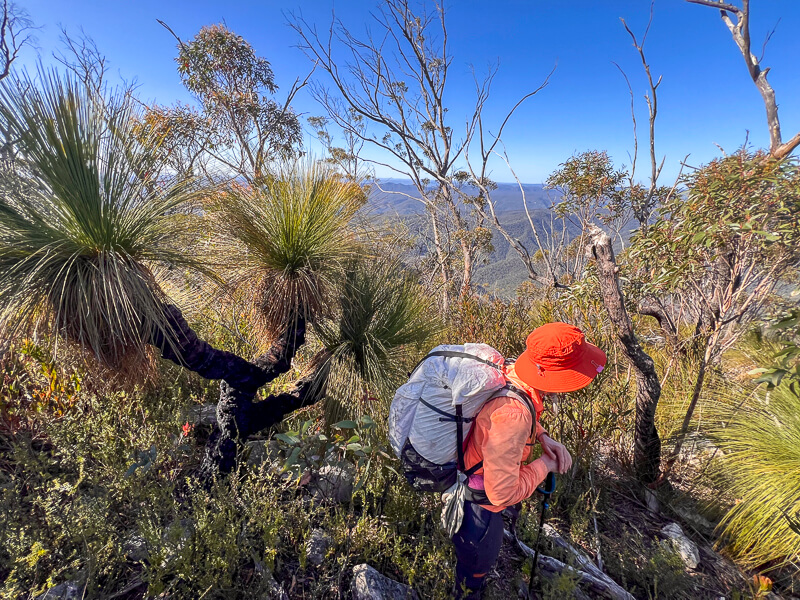
Macpac Ultralight Pack Liner – 50L
In the Blue Mountains, the weather changes fast. Really fast. Although the Whippa pack is pretty good at keeping water out, the seams on the base (if you put it down) can tend to let a bit of ooze in. A waterproof pack liner is essential, and I much prefer this approach over fussing with rain covers or stuffing everything into separate dry bags. Simple, light, and it works. Buy here.
Nemo Hornet Osmo 1P Ultralight Tent – 1kg
At around 1kg, this tent punches well above its weight for comfort, roominess and weather protection. I tossed up whether to opt for the Elite model, shaving off 200g, but reviews out of the UK (think Peak District weather) swayed me for the standard one. Stay tuned for my full review on this coming soon. Buy here.
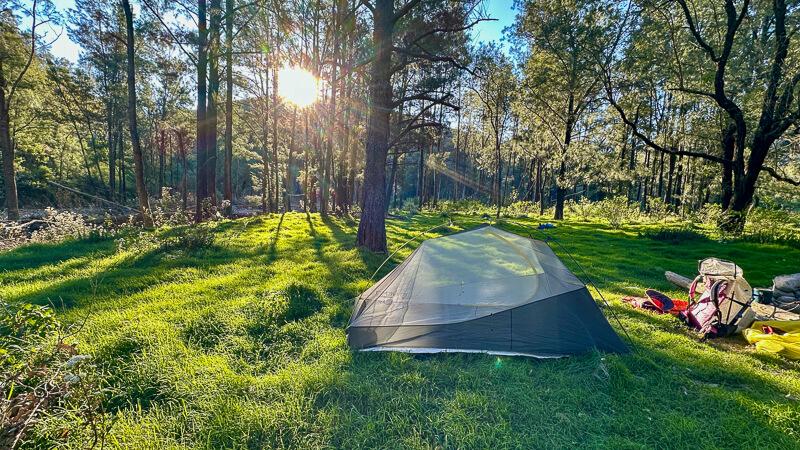
Tyvek Footprint – 130g
Traditionally used as house wrap in construction, Tyvek is basically bombproof and weighs almost nothing. It’s an easy choice to protect the floor of a tent, instead of the standard footprint. Buy here.
Sea to Summit Ether Light XR Sleeping Mat – 445g
Look, I’m all for going lightweight, but comfort matters when you’re out for multiple days. This mat gives you proper cushioning (I’m talking 10cm of airy, luxury, goodness) without the weight penalty, and the insulation saved me on those cooler nights. Well worth the grams for me, though others might choose lighter options. Buy here.
Sea to Summit Flame III Sleeping Bag – 850g
Rated to -4°C, this 850+ loft down bag is my go-to for about 80% of the year. No longer available, I’ve linked to a newer model here, which has updated materials but similar performance (-2c). For me, down is still the winner when you’re watching weight.
Sea to Summit Aeros Premium Pillow – 79g
Some people skip the pillow. Sure, I could sleep on my rolled-up rain jacket, but meh, at under 80 grams I couldn’t be bothered. It’s a tiny luxury that makes a real difference to my sleep quality—and sleep matters when you’re tackling challenging terrain day after day. Buy here.
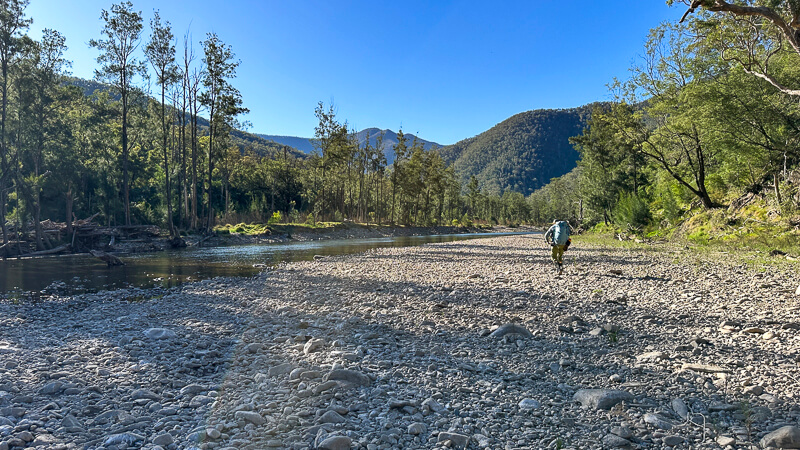
Kitchen and Hydration
Cooking Kit (Stove, Pot, Cup, Spoon) – 470g
I use a metho stove system from TrailDesigns—dead simple, reliable, and light. I’ve tweaked my cook system to nest everything inside a GSI FairShare mug, and I’ve got a titanium spoon and Sea to Summit collapsible cup to round things out. Alcohol stoves are brilliant for peace and quiet over speed (cough, JetBoil/Pocket Rocket) plus you don’t have to lug gas canisters around.
Fuel (Methylated Spirits) – 240g
About 240 grams of metho covered four days of cooking with a bit left over for safety. That works out nicely for morning porridge and rehydrating dinner, with room to spare. My stove takes 30mls of metho per boil.
Opinel No 8 Bushwhacker – 47g
This classic French knife does everything I need around camp. Light, sharp, reliable—what more do you want? Oh, wait. The fact that this one was found buried deep in the sandy beach at Gungaddy, covered in fish guts, which my good mate cleaned up and gifted to me. Buy here.
Water Bladder 10L – 49g (empty)
An empty goon bag weighs basically nothing when empty, but lets me carry extra litres when I need to. And in Kanangra, where water can be scarce (or non-existent) along the ridgelines, that flexibility is gold. I ended up carrying 5L up on the toughest day. Even with an early start, the warm day made me glad I did.
Hydration Pack – Hydrapak 2L – 142g
I’m a hose kinda gal. They’re not for everyone. My walking buddy prefers bottles on the side of the pack. Whatever works to make sure you stay hydrated. Buy here.
Grayl Ultrapress Water Filter – 350g
Water treatment isn’t optional in the bush. The Grayl filters and purifies in one press—bacteria, protozoa, viruses, all gone. Sure, it’s heavier than Micropur tablets, but I really value the peace of mind and instant drink – no waiting for treatment or a slow drip. That said, this is one area where I could definitely cut weight if I wanted to (more on that below). Buy here.
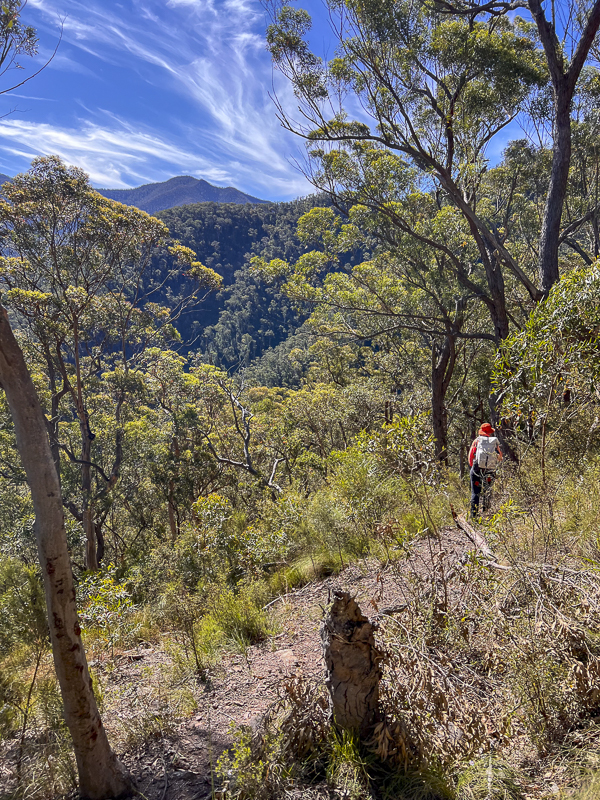
Food for Four Days (approx 2.5kg)
Getting the food balance right on a multi-day hike is crucial—you need enough fuel without carrying excessive weight. I aimed for simple, lightweight options that pack down well and don’t require elaborate preparation after a long day on my feet.
Breakfast (3 x mornings) ~210g total
Three sachets of Uncle Tobys porridge at 36g each provided easy, warm starts to the day. I added Frisp freeze-dried strawberries and mango (2 x 15g) for flavour and extra energy without the weight of fresh fruit.
For coffee, I used three Laughing Pug coffee drip bags—a brilliant invention for proper coffee in the bush without carrying my beloved Aeropress. I also packed three black tea bags and three herbal tea bags for variety and evening drinks.
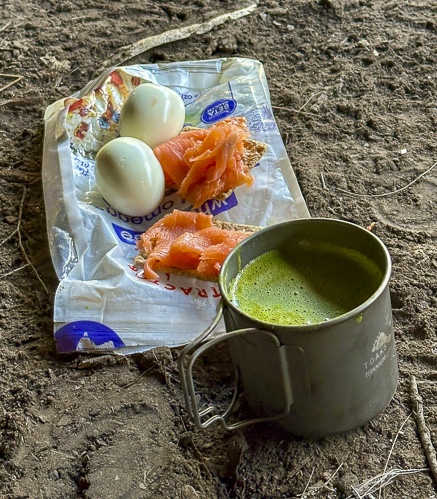
Lunch (4 x days) ~800g total
My lunches were based around wraps—four tortillas that pack flat and don’t crush like bread. Each day I’d make up a wrap with one Baby Belle cheese (yes, my fellow Australians, ‘Baby Cheesus‘), three fresh green beans for crunch, two cherry tomatoes, and a mini salami. My version of a ham, cheese, tomato wrap, but the beans add that satisfying crunch you miss in the bush.
Fresh vegetables might seem odd for lightweight packing, but cherry tomatoes (in an old plastic vitamin jar) and beans are surprisingly robust, and the psychological boost of fresh food on day three is worth a few extra grams to me.
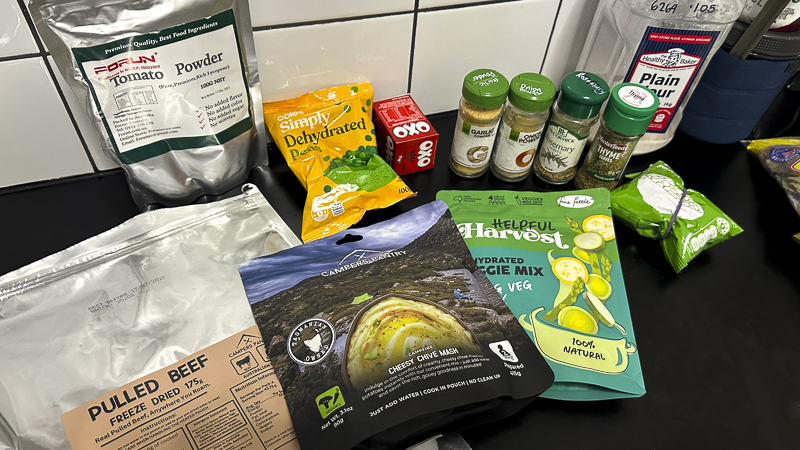

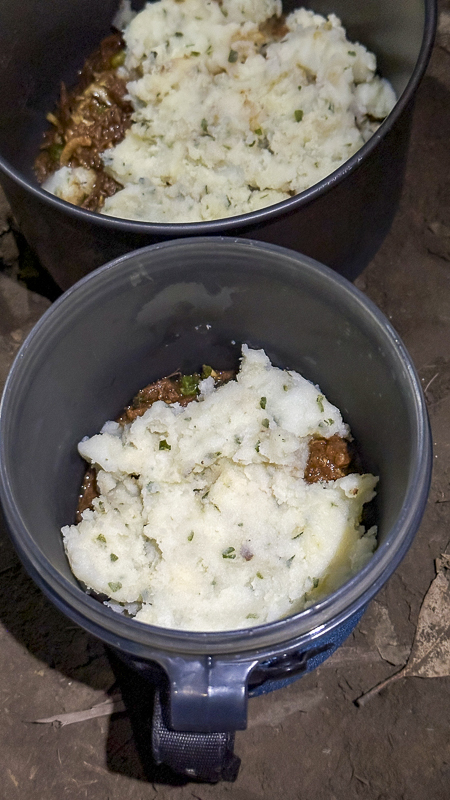
Dinner (3 x nights)
Night one: Campers Pantry Indian Chicken Pilaf – 100g. Simple, tasty, fast – add boiling water. Buy here.
Night two: I made a dehydrated Shepherd’s Pie based on a Recipe Tin Eats recipe (thanks Nagi), switching out for dry sauce ingredients (20g) plus Campers Pantry pulled beef (56g) and Campers Pantry cheesy chive mash (90g). I prepped enough for two serves as I was sharing food duties with my walking buddy—dividing meal prep is a smart way to reduce pack weight and cooking gear between mates. Buy Campers Pantry here.
Night three: I didn’t have to carry (or cook) it – my friend did!
Snacks
I also carried various snacks—muesli bars and scroggin —distributed throughout my pack for easy access during the day. I find grazing throughout the day works better than long lunch stops when you’re covering serious distance or elevation change.
Weather Protection
Macpac Traverse Rain Jacket – 270g
This 3-layer Pertex jacket handled Kanangra’s wind and weather brilliantly. It’s light but tough, breathes well when you’re working hard uphill, and keeps you dry when the rain hits. Which it did, on day three. Buy here.
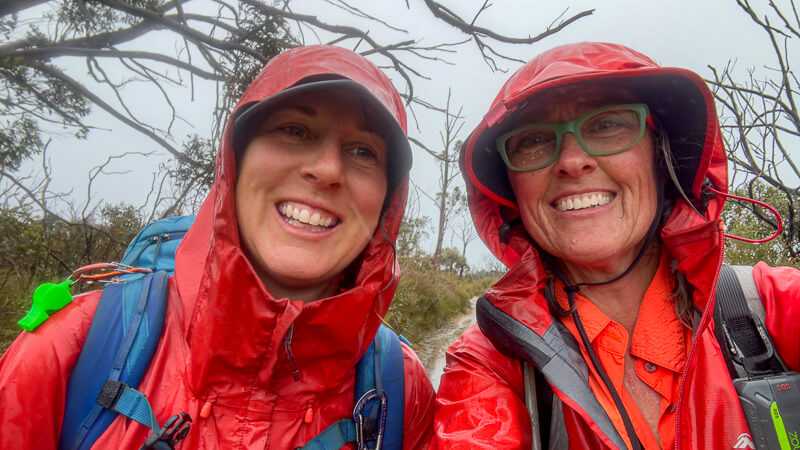

Macpac Nazomi Rain Pants – 170g
Full rain pants are essential for me when pushing through wet scrub, waiting out a storm or hiking somewhere with a reputation for changeable conditions. These pack down small and go on fast—something I was very grateful for when that weather rolled in. Buy here.
Macpac Pisa Technical Warmth – 320g
The critical warmth mid-layer that goes everywhere. Chuck it in the washing machine, chuck it in the dryer, it’s one of those Polartec Alpha Direct jackets that are great for warmth:weight ratio, breathability and moisture wicking. Buy here.
Macpac Merino Thermals (Top, Bottoms, Beanie) – 469g
Merino is still the best for layering in my experience. This thermal set kept me warm in camp, plus the natural odour resistance means you don’t get too pongy after a few days out… maybe just smell a bit like a wet sheep. Buy here.
Riggers Gloves – 72g
People often forget gloves, but they’re brilliant when you’re scrambling through scrubby vegetation or dealing with cold, wet gear in the morning. These tradie gloves are cheap, tough, and saved my hands more than once during the never-ending acacia regrowth, laywer vine and off-track bits.
What did I wear?
Great question. The only change of clothes I took was undies. I wore the same hiking pants, long-sleeve Mont shirt, sun hat, Merrell MOABs, socks and gaiters for the whole trip. Aye. Yes. The stench was real and the rain at the end washed it all away… almost.


Safety and Communication
RescueMe PLB1 Personal Locator Beacon – 116g
A PLB isn’t negotiable for me. This lightweight model gives you one-touch emergency contact via satellite when there’s zero mobile coverage. I never walk without one. I’ve written various articles over the years comparing different systems, here’s one. Buy here.
ZOLEO Satellite Communicator – 150g
Two-way satellite messaging lets me check in with family and grab weather updates in the field. The peace of mind is worth it to me—and my safety contact appreciates the daily “I’m OK” check-in messages. That said, this is a comfort item rather than essential safety gear if carrying a PLB. (I know what you’re thinking, ‘she carries both?’… Yep!) Oh, and if you want to want to read my review of Zoleo, it’s here.
iPhone 14 – 239g
Beyond emergencies, my phone is my camera, GPS via Gaia app (with offline maps downloaded) and even my bush-nerdy flora/fauna interp. Paired with the power bank below, it stays charged the whole trip and is attached to my belt loop via a long piece of hi-viz cord. I’m not losing this puppy over a cliff/into river/over waterfall.
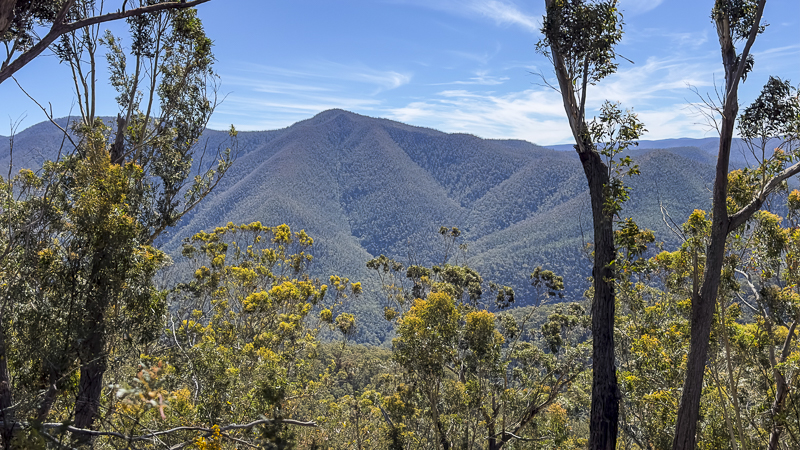
Nitecore NB20000 Gen3 Power Bank – 291g
With 20,000mAh on tap, this kept my phone running for four days. I’d forgotten to charge my headtorch before leaving, so was able to top that up too, with charge still to spare. The capacity-to-weight ratio is pretty impressive—definitely one of the better options if you’re powering multiple devices. Buy here.
Petzl Actik Core Headtorch – 118g
Rechargeable means no spare batteries to carry (see above!). The 600-lumen output handles everything from navigating to camp tasks, and the red light mode keeps your night vision intact. Buy here.
First Aid Kit – 830g
This is one of my heavier items, but a medical kit isn’t something I compromise on. It covers common bushwalking injuries and more serious situations—essential when you’re hours from help. I go through mine regularly to make sure everything’s current and appropriate for the trip, and re-certify my Remote (or Wilderness) Area First Aid course every three years – knowledge weighs nothing!
Personal Care and Hygiene
Toilet Kit (Paper, Hand Sanitiser, Folding Trowel) – 236g
Everything I need for Leave No Trace principles: folding trowel (to dig 15cm down), hand sani, tampons, biodegradable (the cheap stuff) toilet paper and ziplock bag. In some high-use areas, I’ll also carry my poo-pot.
Toothbrush, Toothpaste, Medications, Salt – 80g
I have a handy folding toothbrush I pair with one of those teeny paste tubes you get from the dentist. All kept in a re-used ziplock produce bag. Salt in a teeny Nalgene for leg cramps.
Chapstick, Sunscreen, Insect Repellent – 68g
My essentials – lip balm and sunscreen. I could do without repellent if I had to.
HRT Gel (Estrogel) – 90g
I see you women-off-a-certain-age. I carried the full bottle this trip, but I’ve since discovered Sandrena single-dose sachets at just 1 gram each. Game changer, thanks to Dr Tatiana for the tip! Chat with your GP to see if it’s right for you.

The Complete Picture
| Item | Weight |
|---|---|
| Whippa 60L Overland Pack | 1,175g |
| Macpac Ultralight Pack Liner 50L | 120g |
| Nemo Hornet Osmo 1P Tent | 1,000g |
| Tyvek Footprint | 130g |
| Sea to Summit Ether Light XR Mat | 445g |
| Sea to Summit Flame III Sleeping Bag | 850g |
| Sea to Summit Aeros Premium Pillow | 79g |
| Cooking Kit | 470g |
| Fuel (Methylated Spirits) | 240g |
| Opinel No 8 Knife | 47g |
| Water Bladder (empty) | 49g |
| HydraPak Hydration Pack | 142g |
| Grayl Ultrapress Water Filter | 350g |
| Macpac Traverse Rain Jacket | 270g |
| Macpac Pisa Technical Jacket | 320g |
| Macpac Nazomi Rain Pants | 170g |
| Macpac Merino Thermals (+ beanie in dry bag) | 469g |
| Riggers Gloves | 72g |
| RescueMe PLB1 | 116g |
| ZOLEO Satellite Communicator | 150g |
| iPhone 14 | 180g |
| Nitecore NB20000 Power Bank | 291g |
| Petzl Actik Core 625 Lumens Headtorch | 88g |
| First Aid Kit | 830g |
| Toilet Kit | 236g |
| Toothbrush, Paste, Medications | 80g |
| Chapstick, Sunscreen, Repellent | 68g |
| HRT Gel (Estrogel) | 90g |
| Food (4 days) | 2,000g (est) |
| Base Weight | 10.5kg + water |
Where I Could Cut Even More Weight
Look, although I’m pretty happy with my pack weight, there’s always room for improvement. Even with this setup sitting just over 10kg, I can see areas where I could shave off more grams if I really wanted to push towards ultralight territory. Whether that’s right for you depends on your priorities and what you’re comfortable with.
The Grayl water filter at 350g is an obvious target. Switching to Micropur tablets—they weigh almost nothing and work brilliantly. I stuck with the Grayl because I wanted the instant drinkability of clean water on this trip—one pump and drink.

The ZOLEO satellite communicator is another 150g I could potentially leave behind. In true emergencies, the PLB does the critical job. The ZOLEO is more about convenience and keeping family informed—nice to have, but not essential if you’re committed to cutting weight.
I could also go lighter on the sleeping mat and power bank. There are mats under 300g that would still provide decent comfort, saving me 150g or so. A smaller capacity power bank would trim another 100g, though I’d need to be more strategic about charging devices.
The thing is, I’m always experimenting. I’m constantly having a sticky beak at what my mates are carrying, reading gear reviews, and trying new ideas. Every trip teaches me something about what I actually use versus what just sits in my pack. My setup keeps evolving, and that’s part of the fun—finding that perfect balance between light enough to enjoy the walk and comfortable enough to enjoy the camp.
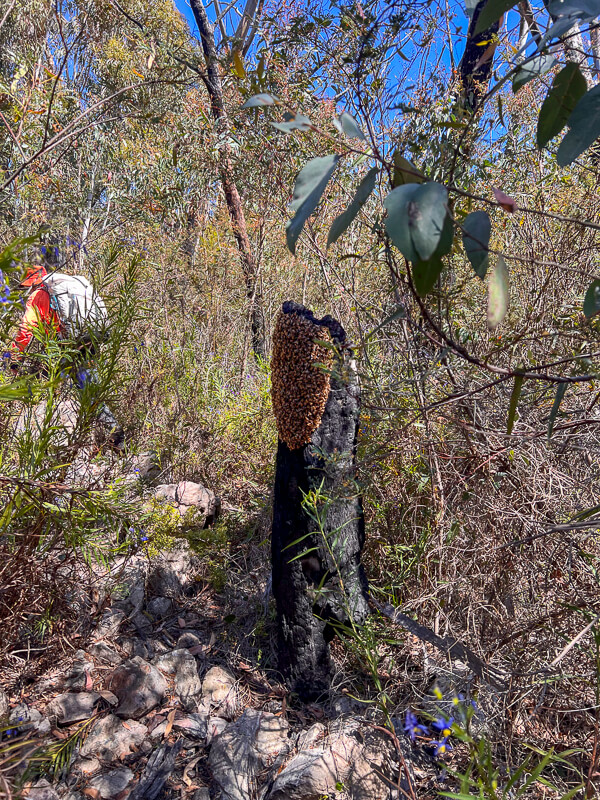
Final Thoughts
Getting to around a 10-kilogram pack weight for four days in challenging terrain means making deliberate choices. Every item I carry earns its spot through a combination of low weight, reliability, and actually being useful. Kanangra-Boyd’s remote location and changeable conditions demand gear you can trust—but that doesn’t mean hauling unnecessary weight.
The secret is quality lightweight gear, cutting out redundancy, and being honest about what you actually need versus what just makes you feel better. This setup kept me comfortable, safe, and moving well through one of Australia’s most spectacular wilderness areas.
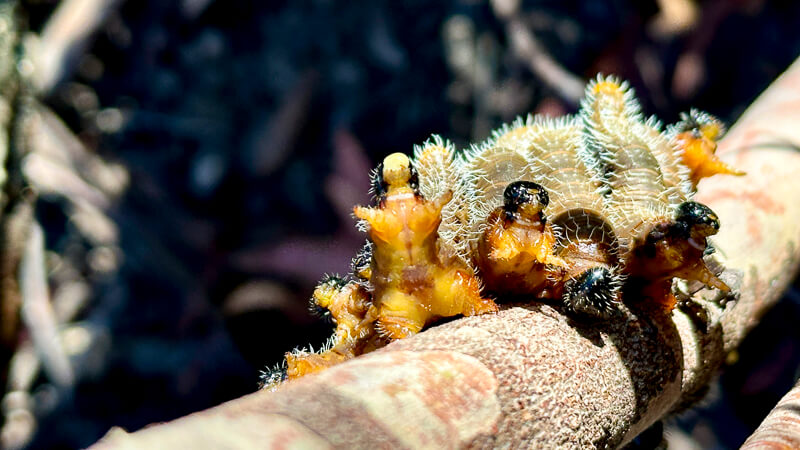
Now, let’s be real—quality lightweight gear is expensive. Looking at this list, the total investment is substantial, I definitely didn’t acquire everything at once and I’ve been lucky to be gifted many of these items over the years. My advice is prioritise the big three items (pack, tent, sleeping bag) first, then gradually upgrade other pieces as budget allows. If you’re just starting out, consider renting gear from outdoor shops or borrowing from friends to test what works before committing to purchases. Many bushwalking clubs also have gear libraries and don’t forget you can hire PLBs for free from some national parks or rent online from top bloke, Neil. Back in the day (2008 for him, 2012 for me), the two of us were pretty much the only Aussies with a bushwalking/hiking blog – before social media and influencers were even a thing.
What’s your target pack weight for multi-day bushwalks? Drop your lightweight gear choices in the comments over on Facebook—I’d love to hear what’s working for you.
